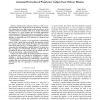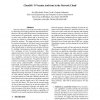10 search results - page 2 / 2 » On JavaScript Malware and related threats |
ACSAC
2010
IEEE
13 years 6 months ago
2010
IEEE
Conficker [26] is the most recent widespread, well-known worm/bot. According to several reports [16, 28], it has infected about 7 million to 15 million hosts and the victims are s...
NDSS
2009
IEEE
14 years 3 months ago
2009
IEEE
Anti-malware companies receive thousands of malware samples every day. To process this large quantity, a number of automated analysis tools were developed. These tools execute a m...
SP
2010
IEEE
14 years 19 days ago
2010
IEEE
Abstract—Unfortunately, malicious software is still an unsolved problem and a major threat on the Internet. An important component in the fight against malicious software is the...
ISSTA
2012
ACM
11 years 11 months ago
2012
ACM
Over the last decade, there has been a significant increase in the number and sophistication of malware-related attacks and infections. Many detection techniques have been propos...
USS
2008
13 years 11 months ago
2008
Antivirus software is one of the most widely used tools for detecting and stopping malicious and unwanted files. However, the long term effectiveness of traditional hostbased anti...


